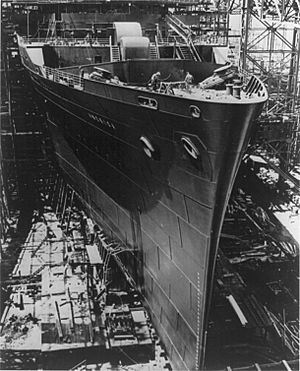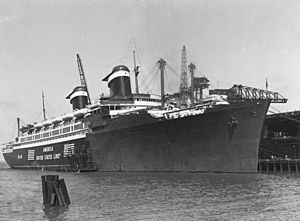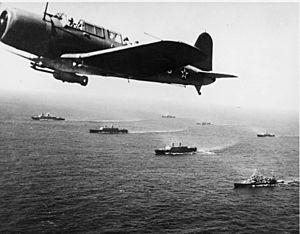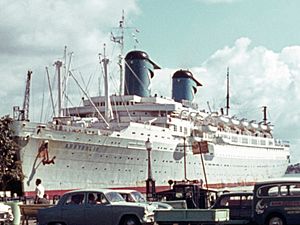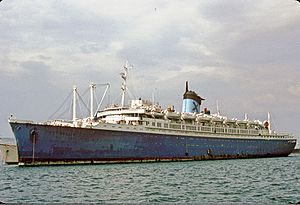SS America (1939) facts for kids

America in 1954
|
|
Quick facts for kids History |
|
|---|---|
| Name |
|
| Owner |
|
| Operator |
|
| Port of registry | |
| Route |
|
| Ordered | 1936 |
| Builder | Newport News Shipbuilding and Drydock Co. |
| Cost | $1.2 million ($20 million in 2021) |
| Yard number | 369 |
| Laid down | 22 August 1938 |
| Launched | 31 August 1939 |
| Christened | 31 August 1939 by Eleanor Roosevelt |
| Completed | 16 April 1940 |
| Acquired | 1 June 1946 |
| Commissioned | 16 June 1941 |
| Decommissioned | 12 March 1946 |
| Maiden voyage | 22 August 1940 |
| In service | 1940 |
| Out of service | 1979 |
| Identification | |
| Fate | Wrecked at Playa de Garcey on Fuerteventura in the Canary Islands in 1994 |
| Notes | Declared a total loss |
| General characteristics | |
| Tonnage |
|
| Displacement |
|
| Length | 723 ft (220 m) |
| Beam | 93 ft (28 m) |
| Draught | 33 ft (10 m) |
| Decks | 11 |
| Installed power | 2 x steam turbines, double reduction geared |
| Propulsion | Twin screw propellors |
| Speed | 22.5 kn (41.7 km/h; 25.9 mph) |
| Capacity |
|
| Crew |
|
| Armament |
|
The SS America was a famous ocean liner and cruise ship built in the United States in 1940. It was designed by a well-known American naval architect named William Francis Gibbs. This ship had many different names during its 54 years, including SS America (three times!), USS West Point, SS Australis, Italis, Noga, Alferdoss, and American Star.
It was most famous for carrying passengers as America and later as the Greek-flagged Australis. The ship met its end as the American Star when it was wrecked off the coast of Fuerteventura in the Canary Islands on January 18, 1994. Over time, the wreck broke apart and sank into the sea. By 2022, it was no longer visible above the water and became an artificial reef for marine life.
Contents
Building the Ship (1936–1939)
The America started being built on August 22, 1938, at the Newport News Shipbuilding and Drydock Company in Newport News, Virginia. It was one of the few ocean liners whose interiors were designed by women. The New York firm Smyth, Urquhart & Marckwald created a modern and friendly design, moving away from the fancy decorations common on older ships.
The goal was to make the ship feel cheerful and elegant. The America was launched on August 31, 1939. Eleanor Roosevelt, who was the wife of then-President Franklin D. Roosevelt, officially named the ship. The liner began its first journey on August 10, 1940, as the main ship for the United States Lines.
Early Journeys (1939–1941)
When first built, the America could carry 543 passengers in cabin class, 418 in tourist class, and 241 in third class. It also had a crew of 643 people. The inside of the ship was designed to be very modern, using materials like stainless steel, ceramics, and new synthetic materials.
The America was first built with short funnels to look sleek and modern. But soon after, the funnels were made 16 feet taller. This was because soot from the funnels was falling onto the decks. The front funnel was actually a fake one, holding the ship's horn and some air vents.
Because World War II had started in Europe, and the United States was still neutral, the ship's name, "United States Lines," and two American flags were painted very large on both sides of the hull. This was to make sure everyone knew it was an American ship. At night, it sailed fully lit up as an extra safety measure. It also sailed in safer waters instead of its planned route across the North Atlantic. On January 3, 1941, it was secretly fitted with a degaussing cable to protect it from naval mines.
On May 28, 1941, the United States Navy called the America into service while it was in Saint Thomas. It was ordered to return to Newport News to be given to the Navy.
Spies on Board
In 1941, two German spies, Franz Joseph Stigler and Erwin Wilhelm Siegler, were part of the ship's crew. While working on the America, they gathered information about ship movements and military defenses at the Panama Canal. They also met with other German agents to help them with their spying. They acted as messengers, passing information between agents in the United States and those on board. Stigler worked as the chief butcher. Both spies stayed on the America until it was changed into a troop transport for the U.S. Navy and renamed USS West Point.
Stigler and Siegler were later caught by the FBI. They were part of a large spy group called the Duquesne Spy Ring.
The America was taken over by the Navy on June 1, 1941, to be used as a troop transport. It was docked at Norfolk, Virginia. The ship was renamed the USS West Point (AP-23). It entered the Norfolk Ship Yards on June 6, 1941, to be converted for military use. On June 15, 1941, it officially joined the Navy under the command of Captain Frank H. Kelley, Jr.
During its conversion, the ship was greatly changed. Life-rafts covered the promenade deck windows, and "standee" bunks (bunk beds) were put everywhere. Several anti-aircraft weapons were installed, and all windows were covered. The ship was painted a camouflage gray color. Its capacity for carrying troops increased to 7,678 people.
The USS West Point then went to New York City. On July 16, it took on board 137 Italian and 327 German citizens from their closed consulates in the U.S. The ship then sailed to Lisbon, Portugal, arriving on July 23. After dropping off these passengers, it took on 321 American citizens and 67 Chinese people, who were consular staff and their families.
Returning to New York on August 1, West Point dropped off its passengers. It then went to Portsmouth, Virginia, for repairs. From August 26 to 29, it took part in training exercises off the Virginia Capes with other ships.
Carrying Troops in World War II
In September 1941, President Roosevelt agreed to provide six U.S. Navy troopships to carry British troops to reinforce the Middle East. The USS West Point was one of these ships.
On November 3, West Point sailed from Virginia to Halifax, Nova Scotia. There, on November 8 and 9, it took on 241 officers and 5,202 men of the British 55th Brigade. On November 10, West Point and five other transports sailed for India as part of Convoy HS-124. Other warships, including the aircraft carrier Ranger, joined them.
On December 7, 1941, the convoy received news of the Japanese attack on Pearl Harbor. On December 9, the convoy arrived in Cape Town, South Africa. On December 13, the troopships left Cape Town for Bombay. The convoy arrived in Bombay on December 27, 1941.
To Singapore and Back (1942)
By December 31, 1941, West Point had finished unloading its troops. On January 9, 1942, West Point sailed for Singapore in a convoy. Captain Kelley, the ship's commander, led the convoy. The convoy included two American ships and three British transports. They were escorted by British warships.
As the convoy neared Java, more escorts joined due to Japanese submarine activity. They took a detour through the shallow Sunda Strait to avoid danger. This was a risky passage, as a small mistake could cause the ships to run aground.
The faster ships, including West Point, sped ahead to reach Singapore by dawn on January 29. They arrived off Singapore and waited for pilots to guide them in. Because the naval base was being bombed daily, the transports went to Keppel Harbor, the commercial port, to unload their troops and cargo.
Singapore Under Attack
West Point began unloading equipment and troops. Most of the troops were ashore before nightfall, except for 670 engineer troops who stayed on board. Air raids by Japanese planes continued until midnight. Local workers would hide during alerts, so the ship's crew and embarked troops had to do most of the unloading.
On January 30, Japanese bombers attacked the city again. Several bombs fell near West Point. Another ship, Wakefield, took a direct hit, killing five men and wounding nine. West Point sent medical officers and corpsmen to help Wakefield.
Later that morning, Captain Kelley learned that his ship would carry Australian troops from Suez to Singapore and evacuate refugees to Ceylon. With the situation becoming urgent, Kelley agreed to take up to a thousand women and children, plus other men the British wanted to send. Many naval and civilian personnel and their families from the dockyard, which was being heavily bombed, were assigned to West Point for evacuation. They carried little baggage or money but were lucky to escape before Singapore fell to the Japanese. In total, about 1,276 people were on board by 6:00 p.m. on January 30.
West Point and Wakefield left Singapore, escorted by a British warship. Overcast weather helped them pass through the Banka Strait without being attacked by Japanese aircraft. They went to Batavia, Java, to pick up more refugees. On January 31, another British ship transferred more personnel to West Point for passage to Ceylon.
Journeys Continue (February 1942 – 1946)
On February 1, West Point left Batavia with Wakefield and escorts. Japanese submarines were active in the area, sinking several ships. On February 4, a baby boy was born on board West Point during the journey.
They arrived at Colombo Harbor, Ceylon, on February 6. The harbor was so crowded that Wakefield could not be repaired there. Passengers also had trouble finding transportation ashore. British authorities then asked the American ships to take personnel to Bombay. West Point took on 8 men, 55 women, 53 children, and 670 troops for India. The two ships left Colombo on February 8.
After dropping off its passengers in Bombay, West Point went to Suez. There, it picked up Australian troops who were leaving the North African Campaign to fight the Japanese in Southeast Asia. Singapore fell on February 15, and Java on March 4. West Point carried its troops to Australia, dropping them off at Adelaide and Melbourne, before heading across the Pacific to San Francisco.
As the Allies prepared to fight back, West Point helped by carrying many troops to America's allies in the southwest Pacific. It took men to Wellington, New Zealand, arriving on May 30. It then returned to New York, arriving on July 2.
After two trips to the United Kingdom, West Point sailed for India and then to Auckland, New Zealand, in December. In 1943, the ship continued transporting troops to Australia and Allied bases in the Central and South Pacific. It also made voyages to places like Bombay, Massawa, Aden, Suez, and Rio de Janeiro.
In 1944, West Point continued its important work, carrying troops to Nouméa, Guadalcanal, and Milne Bay. It then sailed to Boston, Massachusetts, arriving on June 12. It made five trips to the United Kingdom before sailing to Oran, Algeria; Casablanca, French Morocco; and Marseille, France.
In 1945, West Point made more voyages to Italian and French ports. After Germany surrendered, it helped bring American troops home from Europe in "Operation Magic Carpet" voyages. After its last European trip to Le Havre, France, West Point was sent to the Pacific Fleet. It sailed from Boston on December 10, 1945, through the Panama Canal, to Manila, Philippines. It returned to New York on February 7, 1946.
Its last trip as West Point was a short one from Portsmouth to Newport News to be changed back into a passenger liner. Six days later, it was officially taken out of service on March 12 and given to the Maritime Commission.
During its time in the Navy, the USS West Point carried over 350,000 troops. This was more than any other Navy troopship in World War II. On one trip in 1944, it carried 9,305 people. It also transported Red Cross workers, United Nations officials, children, civilians, prisoners of war, and U.S.O. entertainers.
Awards
During its service in the U.S. Navy, West Point received these awards:
- American Defense Service Medal
- European-African-Middle Eastern Campaign Medal
- Asiatic-Pacific Campaign Medal
- World War II Victory Medal
After the War
United States Lines (1946–1964)
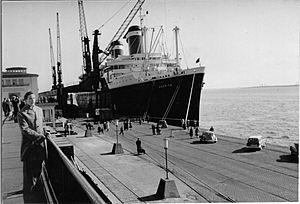
After the war, the America's career was successful. It finally sailed the New York–Le Havre–Bremerhaven–Cobh route, which had been delayed by World War II. Many ship lovers thought it was the most beautiful American-flagged liner. It was smaller and more graceful than its faster sister ship, the SS United States, which launched in 1952.
The America and United States were very different, so they didn't work together as well as other famous ship pairs. After 1955, it continued to sail the US–Europe route and also visited tropical places like Bermuda and the Caribbean. In 1962, it made fourteen trips across the Atlantic, and eight in 1963. However, it was docked in Hoboken for five months starting in September 1963 due to worker strikes.
Chandris Line (1964–1978)
On November 16, 1964, the America was sold to the Greek-owned Chandris Group. At 24 years old, the ship was getting old and faced competition from newer, faster ships and long-distance air travel. The postwar market for carrying emigrants from Europe to Australia became a good business for passenger ships that couldn't attract luxury travelers.
The America was renamed Australis (meaning "Australia," a common name for Chandris liners) and was greatly refitted. About 350 new cabins were added, and many existing cabins got extra beds. This increased the passenger capacity from under 1,200 to 2,258.
Its first voyage as Australis was from Southampton on August 21, 1965, to Australia and New Zealand. It returned to Southampton via the Pacific and Panama. After that, it regularly sailed this round-the-world route. When the Suez Canal closed in 1967, it sailed south via Cape Town instead of stopping at Piraeus.
On October 22, 1970, a fire broke out in the galley, causing delays. On July 11, 1974, Australis had a small collision with the Australian aircraft carrier HMAS Melbourne in Sydney Harbour. Both ships had minor damage, but no one was hurt.
It was the last liner to offer regular service to Australia and New Zealand from Southampton. Its final voyage left on November 18, 1977. After arriving in Auckland, it was docked in Timaru on December 23, 1977. Rising fuel costs and the rise of jetliners caused Chandris to stop using Australis for the Australian route in 1978.
Venture Cruise Lines (June 1978 – August 1978)
After being docked in Timaru, New Zealand, Australis was sold to Venture Cruise Lines in New York. The ship was renamed America again, hoping to use its American history to attract passengers. Its hull was painted dark blue, and the funnels were repainted blue and red.
America began its first cruise on June 30, 1978. However, its refit was not finished. The ship was in very poor condition, with dirty linens, worn mattresses, and trash everywhere. There was a strong smell of kitchen odors and engine oil, and plumbing issues. Water leaked from pipes onto the decks.
Attempts to fix up the ship also caused problems. Many layers of paint were visible on the ship's outside, and the stainless-steel parts in public rooms were scratched with paint. Because the ship was overbooked and unfinished, many passengers protested. They forced the captain to return to New York. Nine hundred sixty passengers left the ship. On a second sailing that day, 200 more passengers left.
America finally left for a five-day cruise to Nova Scotia on July 3, 1978. When it arrived, it faced $2.5 million in claims from unhappy passengers. More problems led to all future cruises being canceled. America was seized on July 18, 1978, because of unpaid debts. An inspection by the US Public Health Service gave America a very low score of six out of 100 points.
On August 28, 1978, a court ordered America to be sold.
Second Chandris Career (1978–1980)
Chandris Lines bought America back for $1,000,000 and renamed her Italis. Her front dummy funnel was very rusty from years of neglect and was removed. There were plans to make the ship look more modern by adding new structures above the bridge, but this was never finished. The ship kept the dark blue hull from Venture Cruise Lines.
Italis first served as a hotel ship from June 23 to July 20, 1979, for a conference in Monrovia, Liberia. It then made three 14-night cruises from Genoa and Barcelona to Egypt, Israel, and the Eastern Mediterranean starting on July 28, 1979. After these cruises, it was finally docked in Elefsina Bay, Piraeus, Greece, on September 12, 1979.
Uncertain Future (1979–1993)
The ship was sold again in 1980 to Intercommerce Corporation and renamed Noga. Intercommerce wanted to turn the ship into a prison ship in Beirut, but this never happened.
In September 1984, the ship was sold to Silver Moon Ferries and renamed Alferdoss (meaning "paradise" in Arabic). However, only the front left side of the ship was renamed, so the back and front right side still showed Noga.
While owned by Silver Moon Ferries, a broken pipe in the engine room caused flooding. The ship quickly tilted to one side. To prevent it from sinking, the ship was quickly moved and beached. After being pumped out and repaired, it was returned to its original spot.
In the late 1980s, the ship was sold for $2 million to be scrapped. The company paid $1 million upfront and started work. They removed the lifeboats and their cranes. But then the company stopped making payments and left.
Alferdoss/Noga stayed in this unfinished state until 1993.
Wrecked at Fuerteventura (1994–2008)
In October 1992, the ship was sold again. The plan was to refit it into a five-star hotel ship off Phuket, in Thailand. When it was drydocked, it was found that the hull was still in good condition despite years of neglect. In August 1993, it was renamed American Star. Its propellers were removed and placed on the deck at the bow. The funnel was painted red, and the bridge was painted orange for the tow. Because the ship was too old to pass through the Suez Canal, it had to go around the Cape of Good Hope to reach Thailand.
The ship left Greece under tow on December 22, 1993. But bad weather made the tow impossible, so it returned to Greece for a few days. On December 31, 1993, American Star left Greece for the last time, being towed by the Ukrainian tugboat Neftegaz-67.
The 100-day tow began. Soon after, American Star and Neftegaz-67 sailed into a thunderstorm in the Atlantic. The tow-lines broke. Six or more crew members went onto the American Star to try to reattach the emergency tow-lines, but they couldn't. Two other tugboats were called to help. On January 17, 1994, the crew on American Star was rescued by helicopter. The ship was left drifting. At 6:15 a.m. on January 18, the ship ran aground at Playa de Garcey, off the west coast of Fuerteventura in the Canary Islands.
While the ship's owners and towing companies discussed what to do, the ship was left to the ocean. The front part of the ship got stuck on a sandbar. Within 48 hours, the strong Atlantic waves broke the ship in two, just past the second funnel. The ship was declared a total loss on July 6, 1994. The 344-foot stern section completely collapsed and sank in 1996. The 379-foot bow section remained mostly intact.
As months passed, the wreck attracted many onlookers and even looters. Locals even created a zipline to the wreck to take valuable items. Because of the rough waves and strong current, reaching the wreck was very dangerous. Over the years, several people trying to swim to the wreck died, while others had to be rescued by helicopter once they got on board. Those who made it on board shared photos of the inside and outside of the wreck, showing empty cabins and water crashing through broken windows. A German documentary in 1999 showed rare views of the wreck's interior and exterior, filmed just after the stern section broke off. For an art project, the film crew brought generators and floodlights to light up the bow section.
By 2004, the bow section was still upright, but the water was eroding cargo hold number 1, making the bow very top-heavy. In November 2005, the left side of the bow section collapsed, causing the ship's remains to tilt much more sharply. The remaining funnel broke off and fell into the ocean. The collapse of the left side also caused the hull to start breaking apart. By October 2006, the wreck had almost completely fallen onto its left side.
In April 2007, the right side finally collapsed, causing the wreck to break in half and fall into the sea.
Debris Field (2008 – Present)

In 2013, people noticed that the wreck was no longer visible on Google Maps. By 2018, only the bow was left visible, and only during low tide.
In 2019, scuba divers took many underwater videos of the American Star's debris field during calm seas. While the ship's hull and upper parts have now fully broken down, there are still recognizable pieces of the vessel half-buried in the sand. The anchor chains on the front deck and a boiler are still very much intact. The detached funnel is also still there. The wreck site is now full of marine life.
See also
 In Spanish: SS America (1940) para niños
In Spanish: SS America (1940) para niños
- SS United States, fleetmate of the America


